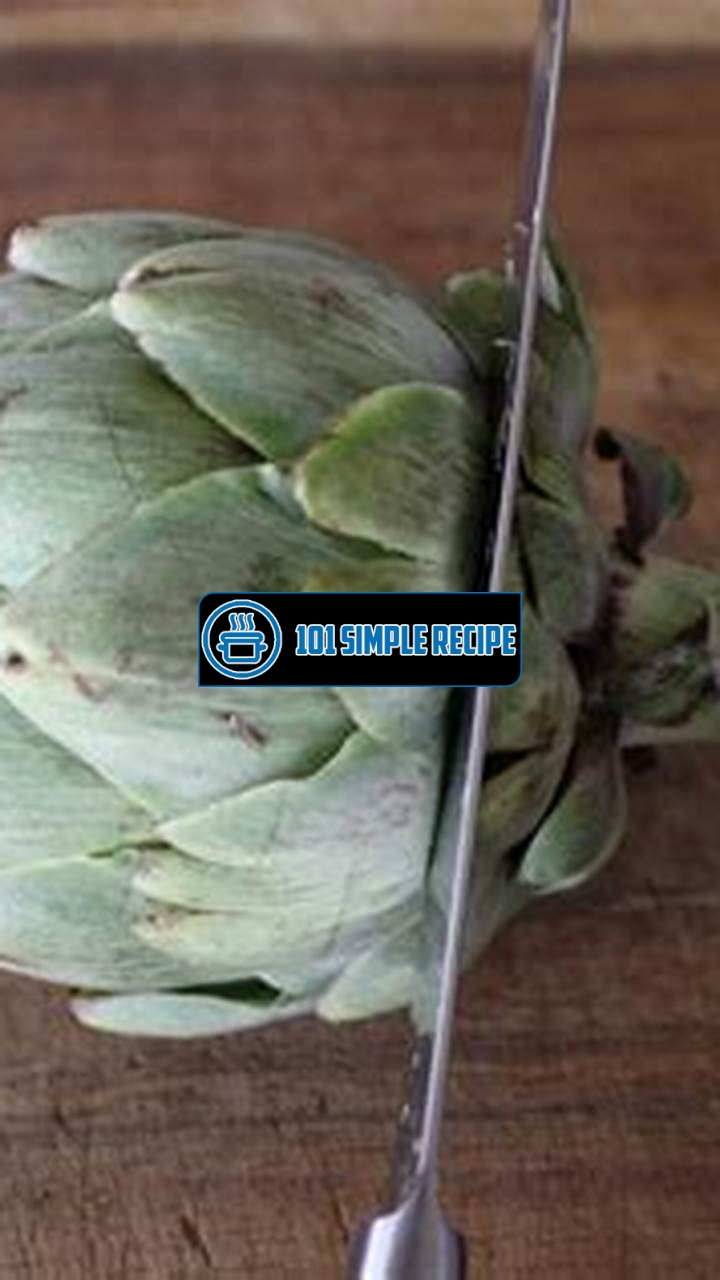Are you looking to add a burst of flavor to your meals? Look no further than the steamed whole artichoke! This delectable vegetable is not only visually appealing but also offers a range of health benefits. Steaming the artichoke locks in its irresistible flavor, resulting in a culinary delight that is hard to resist. Whether you are a seasoned artichoke enthusiast or a curious food lover, exploring the world of steamed whole artichokes will surely be a treat for your taste buds. ️ So, let’s dive in and unravel the wonders of this fabulous vegetable!

The Art of Steaming Whole Artichoke
Unlock the secrets of steaming whole artichoke to create a delicious and nutritious dish that will leave your taste buds craving for more. Steaming is a simple and healthy cooking method that preserves the natural flavors and nutrients of the artichoke, resulting in a tender and flavorful vegetable that is a true delight to enjoy.
The Delight of Artichokes
Artichokes are not only a visually appealing vegetable, but they also offer a unique and delightful flavor. With their slightly sweet and nutty taste, artichokes add a burst of freshness to any dish. They are also packed with vitamins, minerals, and antioxidants, making them a healthy addition to your diet. Whether you serve them as a side dish, use them as a topping for salad, or incorporate them into various recipes, artichokes are a versatile ingredient that can elevate the taste of any meal.
Choosing the Perfect Artichoke
When it comes to selecting artichokes for steaming, you want to choose ones that are fresh and firm. Look for artichokes with tightly closed leaves and a vibrant green color. Avoid artichokes that have brown or black spots, as this may indicate spoilage. Additionally, the size of the artichoke can also affect its texture and flavor. Smaller artichokes tend to be more tender, while larger ones may require longer cooking times. It’s always helpful to give the artichoke a gentle squeeze – a good one will feel firm and heavy.
Another important aspect to consider is the stem of the artichoke. A fresh artichoke will have a firm and plump stem. If the stem looks dry or woody, it’s best to choose another artichoke. The stem plays a crucial role in the steaming process, as it absorbs the flavors and moisture during cooking. Therefore, having a healthy stem will contribute to the overall taste and texture of the steamed artichoke.
Preparing Artichokes for Steaming
Before you begin the steaming process, it’s essential to properly prepare the artichokes. Start by removing any loose or damaged outer leaves by gently pulling them downwards. Then, using a sharp knife, trim about half an inch from the top of the artichoke, as well as the stem. This will help remove any thorny tips and create a neater appearance.
Next, rinse the artichokes under cold water, making sure to get rid of any dirt or impurities. If desired, you can also soak the artichokes in lemon water for a few minutes to prevent them from browning. Once they are clean and ready, you can proceed with the steaming process.
Steaming whole artichokes is a relatively simple process. Place the cleaned artichokes in a steamer basket, making sure there is enough space between them for the steam to circulate. Fill a pot with an inch or two of water and bring it to a boil. Then, carefully place the steamer basket on top of the pot, cover it with a lid, and reduce the heat to medium-low. Allow the artichokes to steam for about 30-40 minutes or until the leaves are tender and easily removed. You can check the doneness by pulling on one of the outer leaves – if it comes off easily, the artichoke is ready to be enjoyed!
Steaming whole artichoke is not only a delicious and healthy way to enjoy this unique vegetable, but it also allows you to unlock its irresistible flavor. By following the art of steaming, you can create a dish that is both delightful and nutritious – a true culinary masterpiece that will impress your taste buds and leave you wanting more.
Health Benefits of Steamed Artichoke
Discover the numerous health benefits that steamed artichoke brings to your diet. Artichoke, a delicious and nutritious vegetable, is packed with essential nutrients that can promote overall well-being. Incorporating steamed artichoke into your meals not only adds a burst of flavor but also provides a wide array of health advantages. Let’s delve into the nutritional value of artichokes, as well as their potential to boost digestive health and reduce cholesterol levels.
Nutritional Value of Artichokes
Artichokes are not only a delectable addition to your diet but also a powerhouse of nutrients. Rich in vitamins, minerals, and antioxidants, they offer a multitude of health benefits. Artichokes are a good source of vitamin C, which strengthens the immune system and boosts collagen production for healthy skin. They also provide a decent amount of vitamin K, essential for blood clotting and maintaining bone health.
In addition to vitamins, artichokes are a great source of dietary fiber, promoting healthy digestion and preventing constipation. They also contain important minerals like magnesium, potassium, and iron, which are essential for various bodily functions.
Boosting Digestive Health
One of the key benefits of steamed artichoke is its ability to support digestive health. Due to their high fiber content, artichokes aid in regulating bowel movements and preventing constipation. Fiber acts as a natural “sweep” in the digestive system, promoting regularity and preventing digestive disorders.
Moreover, artichokes contain a unique compound called cynarin, which stimulates the production of bile. Bile plays a crucial role in fat digestion by emulsifying fats and aiding in their absorption. By enhancing bile production, artichokes promote efficient digestion and can help alleviate symptoms of indigestion, such as bloating and gas.
The high level of antioxidants found in artichokes also contributes to their digestive benefits. These antioxidants help protect the liver and promote its detoxification abilities, ensuring optimal digestion and overall digestive health.
Reducing Cholesterol Levels
Steamed artichoke has been found to possess cholesterol-lowering properties, making it a valuable addition to a heart-healthy diet. Artichokes contain compounds called flavonoids, which can help lower LDL cholesterol levels, often referred to as “bad” cholesterol. By reducing LDL cholesterol, artichokes can help reduce the risk of heart disease and stroke.
Furthermore, artichokes are rich in a type of fiber called soluble fiber, which is known for its cholesterol-lowering effects. Soluble fiber binds to cholesterol in the digestive system, preventing its absorption into the bloodstream. This mechanism helps lower overall cholesterol levels, contributing to a healthier cardiovascular system.
In conclusion, steamed artichoke offers a myriad of health benefits, from its impressive nutritional value to its ability to boost digestive health and reduce cholesterol levels. Adding this delicious vegetable to your diet can provide a flavorful and nutritious way to enhance your overall well-being.
Mastering the Steaming Process
When it comes to cooking a steamed whole artichoke, mastering the steaming process is essential to achieve the perfect texture and flavor. By following a step-by-step guide, you can ensure that your artichoke turns out tender and delicious. Here is a detailed breakdown of the steaming process:
Preparing the Steamer
To begin, you will need a steamer basket or pot with a tight-fitting lid. Fill the pot with enough water to create steam but not so much that it touches the bottom of the steamer basket. Place the steamer basket inside the pot and make sure it sits securely. This will ensure that the artichoke is cooked evenly.
Pro tip: Adding a few lemon slices to the water can enhance the flavor of the artichoke.
Trimming and Prepping the Artichoke
Before steaming the artichoke, it is important to trim and prep it properly to remove any tough or inedible parts. Start by cutting off the top one inch of the artichoke using a sharp knife. Then, use kitchen shears to trim the sharp, pointed ends of the outer leaves. This will make the artichoke easier to handle and eat.
Next, use a vegetable peeler to remove the tough outer layer of the stem. Trim any remaining tough or fibrous parts from the stem and base of the artichoke. Finally, rinse the artichoke under cold water to remove any dirt or debris.
Steaming Time and Techniques
Now that your artichoke is prepped and your steamer is ready, it’s time to start steaming. Place the artichoke, stem-side down, into the steamer basket. Cover the pot with the lid and turn the heat to medium-high. Let the artichoke steam for about 25-35 minutes, depending on its size.
Pro tip: To check for doneness, carefully insert a knife into the base of the artichoke. If it goes in smoothly and the leaves are easily pulled off, the artichoke is ready.
While the artichoke is steaming, you can prepare a delicious dipping sauce or simply enjoy it with melted butter, mayonnaise, or aioli. Once fully steamed, remove the artichoke from the steamer and let it cool for a few minutes before serving. To eat, simply pull off the leaves one by one and scrape the tender flesh with your teeth.
Steaming a whole artichoke may seem daunting at first, but by following these step-by-step instructions, you will become a master at it in no time. The process of steaming preserves the natural flavor and nutrients of the artichoke, making it a healthy and delicious addition to any meal.
Serving and Pairing Suggestions
When it comes to serving and pairing steamed whole artichokes, the possibilities are endless. Whether you’re looking for a simple appetizer or a main course, you can get creative with the ways you serve and combine this delightful vegetable for a truly memorable culinary experience.
- Artichoke Hearts: To start, you can simply serve the tender artichoke hearts on their own. Sprinkle them with a pinch of sea salt and a squeeze of lemon juice for a burst of flavor. These make for a light and refreshing appetizer.
- Savory Dips and Sauces: If you want to take your artichoke experience to the next level, pair them with savory dips and sauces. One classic option is a tangy garlic lemon aioli. The creamy sauce complements the earthy flavor of the artichokes perfectly. Alternatively, a simple melted herb butter can add richness and depth to each bite.
- Creative Artichoke Recipes: If you’re feeling adventurous, you can incorporate steamed artichokes into various creative recipes. For example, you can chop them up and mix them with fresh herbs, garlic, and breadcrumbs to create flavorful artichoke stuffing for roasted chicken or turkey. You can also toss steamed artichoke hearts with pasta, sun-dried tomatoes, and olive oil for a delicious and satisfying vegetarian dish.
- Wine Pairing for Artichoke: To complement the unique flavors of steamed artichokes, it’s important to choose the right wine. Artichokes can be tricky to pair with wine because their distinct taste can overpower many varietals. However, a crisp and acidic white wine, such as Sauvignon Blanc or Pinot Grigio, can complement the subtle flavors of artichokes. Alternatively, if you prefer red wine, opt for a light-bodied and fruity Pinot Noir or Beaujolais.
When serving steamed whole artichokes, it’s important to remember that the preparation process may require a bit of effort from your guests. However, the rewarding experience of breaking off the leaves, dipping them into flavorful sauces, and savoring the tender heart makes it all worthwhile. So get creative with your serving and pairing suggestions and enjoy the irresistible flavor of steamed whole artichokes!
Troubleshooting and Frequently Asked Questions
When it comes to steaming whole artichokes, there can be a few common challenges that you may encounter. In this section, we will discuss how to overcome these challenges and provide answers to some frequently asked questions.
Dealing with Tough Outer Leaves
One of the main challenges when preparing whole artichokes is dealing with tough outer leaves. These leaves can be quite fibrous and difficult to eat. However, there are a few simple steps you can take to remedy this.
1. Trim the leaves: Start by trimming the tough outer leaves of the artichoke. Use a pair of kitchen shears to cut off the tough tips of the leaves. This will make it easier to remove the outer layers later on.
2. Steam for longer: If you find that the outer leaves are still tough after steaming the artichokes, try increasing the steaming time. This will soften the leaves and make them more enjoyable to eat.
3. Remove the outer layers: If the outer leaves are still too tough to eat, you can simply remove them before serving. Gently pull off the outer layers until you reach the softer, more tender leaves underneath.
Understanding Bitterness
Another common concern when steaming whole artichokes is the potential bitterness that can be associated with certain varieties. Fortunately, there are a few ways to address this issue and ensure a more enjoyable dining experience.
1. Choose the right variety: Some artichoke varieties are naturally less bitter than others. Look for baby artichokes or those labeled as “sweet” or “mild” to avoid excessive bitterness.
2. Soak in lemon water: Before steaming the artichokes, you can soak them in water that has been mixed with lemon juice. This can help to reduce bitterness and enhance the overall flavor.
3. Remove the choke: The choke, found in the center of the artichoke, can sometimes contribute to bitterness. Make sure to remove it before eating. Simply use a spoon to scoop out the fuzzy choke.
Storing and Reheating Leftover Artichoke
If you have leftover steamed artichokes, you can store them in the refrigerator for a few days and enjoy them later. Here are some tips for storing and reheating leftover artichokes:
1. Store properly: Place the leftover artichokes in an airtight container or wrap them tightly in plastic wrap. This will help to keep them fresh and prevent them from drying out.
2. Reheat gently: When you’re ready to eat the leftover artichokes, reheat them gently to avoid overcooking. You can steam them for a shorter time or even briefly microwave them.
3. Add some flavor: If the reheated artichokes seem a bit bland, you can spruce them up with some additional flavor. Try drizzling them with olive oil, squeezing fresh lemon juice over them, or sprinkling them with herbs and spices.
By following these troubleshooting tips and answering frequently asked questions, you’ll be able to tackle any challenges that may arise when steaming whole artichokes. Enjoy the irresistible flavor of this delicious and healthy vegetable!
Frequently Asked Questions
Here are some frequently asked questions about steamed whole artichokes:
| No. | Questions | Answers |
|---|---|---|
| 1. | How long does it take to steam a whole artichoke? | Steaming a whole artichoke usually takes about 30-45 minutes, depending on the size of the artichoke. It’s important to cook it until the leaves are tender and can be easily pulled off. |
| 2. | What is the best way to prepare an artichoke for steaming? | To prepare an artichoke for steaming, first trim the stem and top of the artichoke. Then, use kitchen scissors to trim the pointed tips of the leaves. Lastly, rinse the artichoke under cold water to remove any dirt or debris. |
| 3. | What should I serve with steamed whole artichoke? | Steamed whole artichoke is delicious on its own or with a dipping sauce. Popular options include melted butter, aioli, or a simple lemon and olive oil dip. |
| 4. | Can I eat the whole artichoke? | While you can eat the leaves of a steamed whole artichoke, the innermost part, called the heart, is the most tender and flavorful. It’s worth saving for the end! |
| 5. | Are steamed artichokes healthy? | Yes, steamed artichokes are a healthy choice. They are low in calories, high in fiber, and packed with vitamins and minerals. They also contain antioxidants and may have potential health benefits. |
| 6. | Can I steam frozen artichokes? | Yes, you can steam frozen artichokes. Just follow the same steaming instructions, but adjust the cooking time slightly longer to account for the frozen state of the artichokes. |
Closing Thoughts
Thank you for taking the time to read about steamed whole artichokes. We hope you found this article informative and inspiring. Next time you’re in the mood for a nutritious and delicious dish, don’t forget to try steaming whole artichokes. They make for a simple yet satisfying meal or appetizer. Remember to visit us again for more culinary adventures and tips. The world of food is vast, and there’s always something new to explore. Happy cooking!
Jump to Recipe
Steamed Whole Artichoke

Learn how to perfectly steam a whole artichoke for a delightful and healthy dish.
- 2 whole artichokes
- 2 tablespoons olive oil
- 2 cloves garlic (minced)
- Salt and pepper to taste
- Trim the stem and top of the artichokes. Use kitchen scissors to trim the pointed tips of the leaves. Rinse the artichokes under cold water.
- Place the artichokes in a steamer basket over boiling water. Cover and steam for 30-45 minutes, or until the leaves are tender and can be easily pulled off.
- In a small saucepan, heat the olive oil over medium heat. Add the minced garlic and cook until fragrant, about 1-2 minutes. Remove from heat.
- Once the artichokes are done, remove them from the steamer basket and let them cool slightly. Serve warm with the garlic oil for dipping. Sprinkle with salt and pepper to taste.






